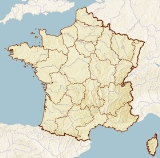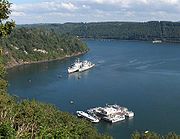
Landévennec
Encyclopedia
Landévennec is a commune
in the Finistère
department of Brittany in north-western France
.
 Shortly before entering the roadstead of Brest
Shortly before entering the roadstead of Brest
, the river Aulne
forms a bend around the Île de Térénez
then the pointe de Pen Forn near Landévennec, where there is 10m depth of water regardless of the tide and with the high surrounding hills blocking the winds and thus keeping the water calm. Here is sited a ship graveyard
for civilian but particularly naval
vessels. The only difficulty is the Capelan bank, to the south of Logonna-Daoulas
, where the depth is less than 5m - this bank has to be passed to reach the base and thus prevents very deep-draught vessels from reaching it
A naval station was first set up here around 1840 to house reserve fleet
vessels and their crews (totalling nearly 200 sailors), and it was visited by Napoleon III and empress Eugénie
during their August 1858 trip into Brittany. During the Second World War the base was used by the German occupiers such as the school ship Armorique (sabotaged in August 1944). Post-war, the ship moved from a base for reserve ships kept in readiness to disarmed naval ships left here for other purposes. Other disarmed French ships have been used as breakwaters before the château de Brest
or as training ships off the naval school at Lanvéoc-Poulmic, but those at Landévennec await demolition or use for target practice in naval exercises at sea. Despite requests from Landévennec's mayor, the aircraft carrier Clemenceau was not retired to the base, with the Capelan bank apparently discouraging pilots from attempting to navigate it into the base. However, having been emptied of nearly all its occupants, in August 2006 the graveyard took on three former breakwaters which would become Brest's "port du Château" and had been moved to allow expansion work to begin. The cruiser Colbert and the Soviet-built hydrofoil ferry Kometa from the Penn-ar-Bed
company (which provided summer services to Ushant
) are now also based here.
Communes of France
The commune is the lowest level of administrative division in the French Republic. French communes are roughly equivalent to incorporated municipalities or villages in the United States or Gemeinden in Germany...
in the Finistère
Finistère
Finistère is a département of France, in the extreme west of Brittany.-History:The name Finistère derives from the Latin Finis Terræ, meaning end of the earth, and may be compared with Land's End on the opposite side of the English Channel...
department of Brittany in north-western France
France
The French Republic , The French Republic , The French Republic , (commonly known as France , is a unitary semi-presidential republic in Western Europe with several overseas territories and islands located on other continents and in the Indian, Pacific, and Atlantic oceans. Metropolitan France...
.
Ship graveyard

Roadstead of Brest
The roadstead of Brest is a roadstead or bay located in the Finistère department in Brittany in northwestern France. The surface area is about 180 km² . The port of Brest is located on its northern edge and one of the two French naval bases...
, the river Aulne
Aulne
The Aulne is a 140 km long river of Brittany in north-western France, flowing down the hills and emptying into the roadstead of Brest, one of the many fjord-like bays just south of Brest. The river is part of the Canal de Nantes à Brest, the navigation canal that once connected the city of Nantes...
forms a bend around the Île de Térénez
Île de Térénez
Île de Térénez is a French islet inside the last bend of the river Aulne, on the territory of the commune of Rosnoën. Its highest point is 18m....
then the pointe de Pen Forn near Landévennec, where there is 10m depth of water regardless of the tide and with the high surrounding hills blocking the winds and thus keeping the water calm. Here is sited a ship graveyard
Ship graveyard
A ship graveyard or ship cemetery is a location where the hulls of scrapped ships are left to decay and disintegrate, or left in reserve...
for civilian but particularly naval
French Navy
The French Navy, officially the Marine nationale and often called La Royale is the maritime arm of the French military. It includes a full range of fighting vessels, from patrol boats to a nuclear powered aircraft carrier and 10 nuclear-powered submarines, four of which are capable of launching...
vessels. The only difficulty is the Capelan bank, to the south of Logonna-Daoulas
Logonna-Daoulas
Logonna-Daoulas is a commune in the Finistère department of Brittany in north-western France.-Population:Inhabitants of Logonna-Daoulas are called in FrenchLogonnais.-References:** ;-External links:* *...
, where the depth is less than 5m - this bank has to be passed to reach the base and thus prevents very deep-draught vessels from reaching it
A naval station was first set up here around 1840 to house reserve fleet
Reserve fleet
A reserve fleet is a collection of naval vessels of all types that are fully equipped for service but are not currently needed, and thus partially or fully decommissioned. A reserve fleet is informally said to be "in mothballs" or "mothballed"; an equivalent expression in unofficial modern U.S....
vessels and their crews (totalling nearly 200 sailors), and it was visited by Napoleon III and empress Eugénie
Eugénie de Montijo
Doña María Eugenia Ignacia Augustina de Palafox-Portocarrero de Guzmán y Kirkpatrick, 16th Countess of Teba and 15th Marquise of Ardales; 5 May 1826 – 11 July 1920), known as Eugénie de Montijo , was the last Empress consort of the French from 1853 to 1871 as the wife of Napoleon III, Emperor of...
during their August 1858 trip into Brittany. During the Second World War the base was used by the German occupiers such as the school ship Armorique (sabotaged in August 1944). Post-war, the ship moved from a base for reserve ships kept in readiness to disarmed naval ships left here for other purposes. Other disarmed French ships have been used as breakwaters before the château de Brest
Château de Brest
The Château de Brest is a castle in Brest, Finistère, France. The oldest monument in the town, it is located at the mouth of the river Penfeld at the heart of the roadstead of Brest, one of the largest roadsteads in the world...
or as training ships off the naval school at Lanvéoc-Poulmic, but those at Landévennec await demolition or use for target practice in naval exercises at sea. Despite requests from Landévennec's mayor, the aircraft carrier Clemenceau was not retired to the base, with the Capelan bank apparently discouraging pilots from attempting to navigate it into the base. However, having been emptied of nearly all its occupants, in August 2006 the graveyard took on three former breakwaters which would become Brest's "port du Château" and had been moved to allow expansion work to begin. The cruiser Colbert and the Soviet-built hydrofoil ferry Kometa from the Penn-ar-Bed
Penn-ar-Bed (company)
Penn-ar-Bed is a French shipping company providing a ferry service between Finistère and the islands of Ushant, Molène and Sein every day of the year, under a public service contract to the Conseil général du Finistère. It is named after Penn-ar-Bed, the Breton name for Finistère...
company (which provided summer services to Ushant
Ushant
Ushant is an island at the south-western end of the English Channel which marks the north-westernmost point of metropolitan France. It belongs to Brittany and is in the traditional region of Bro-Leon. Administratively, Ushant is a commune in the Finistère department...
) are now also based here.
Population
See also
- Communes of the Finistère department
- Landévennec AbbeyLandévennec AbbeyLandévennec Abbey was a monastery in Brittany, now in Finistère, France. It existed from its foundation at Landévennec, traditionally by Winwaloe in the late fifth century, to 1793, when the monastery was abandoned and sold. In 1950 it was bought and rebuilt by the Benedictines of Kerbénéat.It...
- Parc naturel régional d'ArmoriqueParc naturel régional d'ArmoriqueThe Parc naturel régional d'Armorique , or Armorica Regional Natural Park, is a rural protected area located in Brittany. The park land reaches from the Atlantic Ocean to hilly inland countryside. There are sandy beaches, swamps, strange rocks, fast rivers and the hills of Monts d'Arrée, all...

